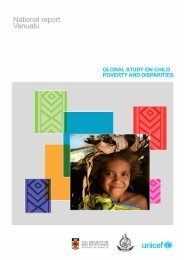A Strategic Assessment of the Children's Services Industry
A Strategic Assessment of the Children's Services Industry
A Strategic Assessment of the Children's Services Industry
- No tags were found...
Create successful ePaper yourself
Turn your PDF publications into a flip-book with our unique Google optimized e-Paper software.
STRATEGIC ASSESSMENT OF THE CHILDREN’S SERVICES INDUSTRYThe result is that, for many countries, <strong>the</strong> ECEC sector is comprised <strong>of</strong> a number <strong>of</strong> differentservice types that are subject to an <strong>of</strong>ten diffuse set <strong>of</strong> policies from a range <strong>of</strong> governmentdepartments. This has been identified as problematic for Australia, Canada and <strong>the</strong> UK(Department for Education and Skills (DfES), 2004; OECD, 2003; Press and Hayes, 2000).Canadian ECEC was described by its OECD Country Note as ‘a patchwork <strong>of</strong> uneconomic,fragmented services’ (2003 p.6). The OECD Country Note for Australia referred to <strong>the</strong> ‘adhoc nature’ <strong>of</strong> Australian early childhood policy and noted that <strong>the</strong> interests <strong>of</strong> children ran<strong>the</strong> risk <strong>of</strong> being subsumed by ‘<strong>the</strong> needs <strong>of</strong> parents, <strong>the</strong> workplace, and <strong>the</strong> economy’ (2001p.37). England's Five Year Strategy for Children and Learners (2004) has sought to addressexisting splits between child care and education.Fragmentation is characteristically found along a number <strong>of</strong> dimensions including:• The diversity <strong>of</strong> services provided, which is <strong>of</strong>ten accompanied by divisions <strong>of</strong>responsibility between different government portfolios.• The various levels <strong>of</strong> government (local/municipal; state/provincial; and national) thathave a direct policy impact on ECEC (particularly in Australia and Canada).• Discontinuities between ECEC and compulsory schooling.• Discontinuities between ECEC and o<strong>the</strong>r areas <strong>of</strong> family policy, such as parentalleave, and welfare to work regimes.• The mix <strong>of</strong> providers – government, not-for-pr<strong>of</strong>it non-government organisations, andfor-pr<strong>of</strong>it businesses and corporations.• Differing standards (regulations, curricula, accreditation) according to jurisdiction and/or type <strong>of</strong> early childhood service.• Differing staffing requirements according to jurisdiction and/or type <strong>of</strong> earlychildhood service.In its Thematic Review <strong>of</strong> Early Childhood Education and Care Policy <strong>the</strong> OECD adopted <strong>the</strong>term ‘early childhood education and care’ in order to reinforce <strong>the</strong> need for a coherentapproach to children’s early development and learning (2001). The juxtaposition <strong>of</strong>‘education’ and ‘care’ highlights <strong>the</strong> intimate interrelationship <strong>of</strong> <strong>the</strong> care and education <strong>of</strong>young children (UNESCO, March 2002). According to <strong>the</strong> OECD (2001), in countries whereearly childhood policy is based upon a foundational understanding that children are competentlearners from birth, divisions between ‘care’ and ‘education’ become meaningless. This rise<strong>of</strong> <strong>the</strong> terminology <strong>of</strong> 'care and education' has, to some extent, changed <strong>the</strong> discourse thatsurrounds <strong>the</strong> provision <strong>of</strong> early childhood services and associated policy. For instance, NewZealand has renamed its child care centres ‘education and care centres’ (May, 2007); <strong>the</strong> NewSouth Wales (NSW) Curriculum Framework for <strong>Children's</strong> <strong>Services</strong> states that <strong>the</strong> interwovennature <strong>of</strong> care and education make it ‘inappropriate to label some services, or even parts <strong>of</strong> <strong>the</strong>day in a programme, as educational and o<strong>the</strong>rs as care’ (undated, p. 16); Sweden uses <strong>the</strong>term förskola (preschool) to encompass its full-time centre based services for children agedbetween 1 and 6 years; and <strong>the</strong> UK has adopted <strong>the</strong> term ‘educare’ to describe ‘joined up’education and child care to children in <strong>the</strong> year before school (DfES, 2004). Notwithstanding<strong>the</strong> adoption <strong>of</strong> more inclusive terminology, for many jurisdictions <strong>the</strong> provision <strong>of</strong> child careand early education remains divided and thus discrepancies in funding and staffing remain.16
















